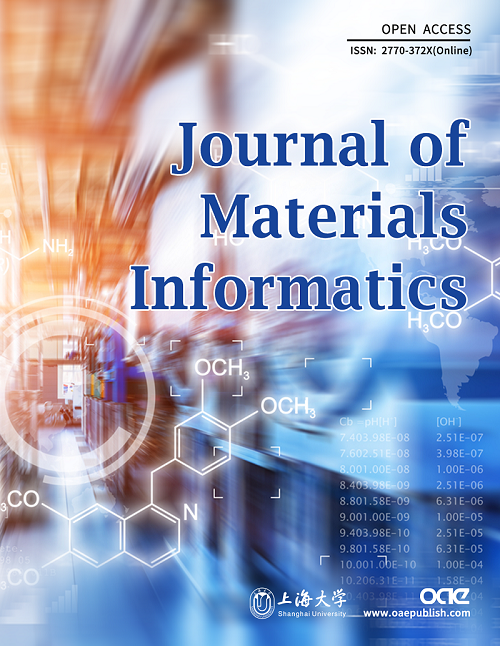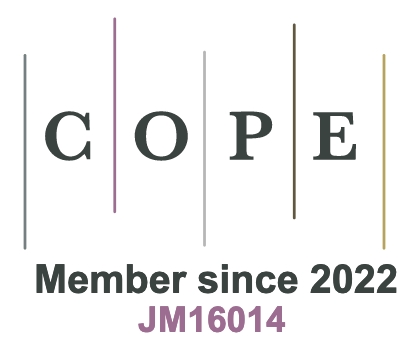REFERENCES
1. Xie, T.; Grossman, J. C. Crystal graph convolutional neural networks for an accurate and interpretable prediction of material properties. Phys. Rev. Lett. 2018, 120, 145301.
2. Ward, L.; Liu, R.; Krishna, A.; et al. Including crystal structure attributes in machine learning models of formation energies via Voronoi tessellations. Phys. Rev. B. 2017, 96, 024104.
3. Wang, T.; Tan, X.; Wei, Y.; Jin, H. Accurate bandgap predictions of solids assisted by machine learning. Mater. Today. Commun. 2021, 29, 102932.
4. Alsalman, M.; Alqahtani, S. M.; Alharbi, F. H. Bandgap energy prediction of senary zincblende III–V semiconductor compounds using machine learning. Mater. Sci. Semicond. Process. 2023, 161, 107461.
5. Li, Y.; Wu, Y.; Han, Y.; et al. Local environment interaction-based machine learning framework for predicting molecular adsorption energy. J. Mater. Inf. 2024, 4, 4.
6. Kohn, W.; Sham, L. J. Self-consistent equations including exchange and correlation effects. Phys. Rev. 1965, 140, A1133-8.
7. Ming, H.; Zhou, Y.; Molokeev, M. S.; et al. Machine-learning-driven discovery of Mn4+-doped red-emitting fluorides with short excited-state lifetime and high efficiency for mini light-emitting diode displays. ACS. Mater. Lett. 2024, 6, 1790-800.
8. Bone, J. M.; Childs, C. M.; Menon, A.; et al. Hierarchical machine learning for high-fidelity 3D printed biopolymers. ACS. Biomater. Sci. Eng. 2020, 6, 7021-31.
9. Zhu, J.; Ding, L.; Sun, G.; Wang, L. Accelerating design of glass substrates by machine learning using small-to-medium datasets. Ceram. Int. 2024, 50, 3018-25.
10. Shim, E.; Tewari, A.; Cernak, T.; Zimmerman, P. M. Machine learning strategies for reaction development: toward the low-data limit. J. Chem. Inf. Model. 2023, 63, 3659-68.
11. Im, J.; Lee, S.; Ko, T.; Kim, H. W.; Hyon, Y.; Chang, H. Identifying Pb-free perovskites for solar cells by machine learning. npj. Comput. Mater. 2019, 5, 177.
12. Yang, J.; Manganaris, P.; Mannodi-Kanakkithodi, A. Discovering novel halide perovskite alloys using multi-fidelity machine learning and genetic algorithm. J. Chem. Phys. 2024, 160, 064114.
13. Liu, C.; Fujita, E.; Katsura, Y.; et al. Machine learning to predict quasicrystals from chemical compositions. Adv. Mater. 2021, 33, 2102507.
14. Isayev, O.; Oses, C.; Toher, C.; Gossett, E.; Curtarolo, S.; Tropsha, A. Universal fragment descriptors for predicting properties of inorganic crystals. Nat. Commun. 2017, 8, 15679.
15. Liu, Y.; Wang, J.; Xiao, B.; Shu, J. Accelerated development of hard high-entropy alloys with data-driven high-throughput experiments. J. Mater. Inf. 2022, 2, 3.
16. Christensen, A. S.; Bratholm, L. A.; Faber, F. A.; Anatole von Lilienfeld, O. FCHL revisited: faster and more accurate quantum machine learning. J. Chem. Phys. 2020, 152, 044107.
17. Bartók, A. P.; Kondor, R.; Csányi, G. On representing chemical environments. Phys. Rev. B. 2013, 87, 184115.
19. Donoho, D. L. High-dimensional data analysis: the curses and blessings of dimensionality. In AMS Conference on Math Challenges of the 21st Century; AMS, 2000. https://dl.icdst.org/pdfs/files/236e636d7629c1a53e6ed4cce1019b6e.pdf. (accessed 16 Jun 2025).
20. Allen, A. E. A.; Tkatchenko, A. Machine learning of material properties: predictive and interpretable multilinear models. Sci. Adv. 2022, 8, eabm7185.
21. Liu, D. D.; Li, Q.; Zhu, Y. J.; et al. High-throughput phase field simulation and machine learning for predicting the breakdown performance of all-organic composites. J. Phys. D. Appl. Phys. 2024, 57, 415502.
22. Rabitz, H.; Aliş, ÖF. General foundations of high-dimensional model representations. J. Math. Chem. 1999, 25, 197-233.
23. Rabitz, H.; Aliş, ÖF.; Shorter, J.; Shim, K. Efficient input - output model representations. Comput. Phys. Commun. 1999, 117, 11-20.
24. Li, G.; Hu, J.; Wang, S. W.; Georgopoulos, P. G.; Schoendorf, J.; Rabitz, H. Random sampling-high dimensional model representation (RS-HDMR) and orthogonality of its different order component functions. J. Phys. Chem. A. 2006, 110, 2474-85.
25. Manzhos, S.; Carrington, T.; Ihara, M. Orders of coupling representations as a versatile framework for machine learning from sparse data in high-dimensional spaces. Artif. Intell. Chem. 2023, 1, 100008.
26. Ren, O.; Boussaidi, M. A.; Voytsekhovsky, D.; Ihara, M.; Manzhos, S. Random sampling high dimensional model representation Gaussian process regression (RS-HDMR-GPR) for representing multidimensional functions with machine-learned lower-dimensional terms allowing insight with a general method. Comput. Phys. Commun. 2022, 271, 108220.
27. Li, G.; Xing, X.; Welsh, W.; Rabitz, H. High dimensional model representation constructed by support vector regression. I. Independent variables with known probability distributions. J. Math. Chem. 2017, 55, 278-303.
28. Chen, H.; Wong, L. L.; Adams, S. SoftBV - a software tool for screening the materials genome of inorganic fast ion conductors. Acta. Crystallogr. B. Struct. Sci. Cryst. Eng. Mater. 2019, 75, 18-33.
29. Wong, L. L.; Phuah, K. C.; Dai, R.; Chen, H.; Chew, W. S.; Adams, S. Bond valence pathway analyzer - an automatic rapid screening tool for fast ion conductors within softBV. Chem. Mater. 2021, 33, 625-41.
30. Li, Y.; Zhu, R.; Wang, Y.; Feng, L.; Liu, Y. Center-environment deep transfer machine learning across crystal structures: from spinel oxides to perovskite oxides. npj. Comput. Mater. 2023, 9, 1068.
31. Perepezko, J. H. Materials science. The hotter the engine, the better. Science 2009, 326, 1068-9.
32. Bewlay, B. P.; Jackson, M. R.; Zhao, J.; Subramanian, P. R.; Mendiratta, M. G.; Lewandowski, J. J. Ultrahigh-temperature Nb-silicide-based composites. MRS. Bull. 2003, 28, 646-53.
33. Shu, J.; Dong, Z.; Zheng, C.; et al. High-throughput experiment-assisted study of the alloying effects on oxidation of Nb-based alloys. Corros. Sci. 2022, 204, 110383.
34. Shi, S.; Zhu, L.; Jia, L.; Zhang, H.; Sun, Z.
35. Xu, W.; Han, J.; Wang, C.; et al. Temperature-dependent mechanical properties of alpha-/beta-Nb5Si3 phases from first-principles calculations. Intermetallics 2014, 46, 72-9.
36. Papadimitriou, I.; Utton, C.; Tsakiropoulos, P. The impact of Ti and temperature on the stability of Nb5Si3 phases: a first-principles study. Sci. Technol. Adv. Mater. 2017, 18, 467-79.
37. Liu, G.; Jia, L.; Kong, B.; Guan, K.; Zhang, H. Artificial neural network application to study quantitative relationship between silicide and fracture toughness of Nb-Si alloys. Mater. Design. 2017, 129, 210-8.
38. Hart, G. L. W.; Mueller, T.; Toher, C.; Curtarolo, S. Machine learning for alloys. Nat. Rev. Mater. 2021, 6, 730-55.
39. Li, Y.; Xiao, B.; Tang, Y.; et al. Center-environment feature model for machine learning study of spinel oxides based on first-principles computations. J. Phys. Chem. C. 2020, 124, 28458-68.
40. Wang, X.; Xiao, B.; Li, Y.; et al. First-principles based machine learning study of oxygen evolution reactions of perovskite oxides using a surface center-environment feature model. Appl. Surf. Sci. 2020, 531, 147323.
41. Tang, Y.; Xiao, B.; Chen, J.; et al. Multi-component alloying effects on the stability and mechanical properties of Nb and Nb–Si alloys: a first-principles study. Metall. Mater. Trans. A. 2023, 54, 450-72.
42. Ouyang, R.; Curtarolo, S.; Ahmetcik, E.; Scheffler, M.; Ghiringhelli, L. M. SISSO: a compressed-sensing method for identifying the best low-dimensional descriptor in an immensity of offered candidates. Phys. Rev. Mater. 2018, 2, 083802.
43. A.A.Baikov Institute of Metallurgy and Materials Science. Database on properties of chemical elements. http://phases.imet-db.ru/elements/mendel.aspx?main=1. (accessed 16 Jun 2025).
44. Ducker, H.; Burges, C. J. C.; Kaufman, L.; Smola, A. J.; Vapnik, V. Support vector regression machines. In Advances in Neural Information Processing Systems. 1996. https://proceedings.neurips.cc/paper_files/paper/1996/file/d38901788c533e8286cb6400b40b386d-Paper.pdf. (accessed 16 Jun 2025).
45. Chang, C. C.; Lin, C. J. LIBSVM: a library for support vector machines. ACM. Trans. Intell. Syst. Technol. 2011, 2, 1-27.
47. Manzhos, S.; Ihara, M. Neural network with optimal neuron activation functions based on additive Gaussian process regression. J. Phys. Chem. A. 2023, 127, 7823-35.
48. Rasmussen, C. E.; Williams, C. K. I. Gaussian processes for machine learning. The MIT Press; 2005. https://gaussianprocess.org/gpml/chapters/RW.pdf. (accessed 16 Jun 2025).
49. Duvenaud, D. K.; Nickisch, H.; Rasmussen, C. E. Additive Gaussian processes. In: Advances in Neural Information Processing Systems. 2011. https://proceedings.neurips.cc/paper_files/paper/2011/file/4c5bde74a8f110656874902f07378009-Paper.pdf. (accessed 16 Jun 2025).
50. Manzhos, S.; Ihara, M. Orders-of-coupling representation achieved with a single neural network with optimal neuron activation functions and without nonlinear parameter optimization. Artif. Intell. Chem. 2023, 1, 100013.
51. Sobol', I. M. On the distribution of points in a cube and the approximate evaluation of integrals. USSR. Comput. Math. Math. Phys. 1967, 7, 86-112.
52. Abarbanel, O. D.; Hutchison, G. R. Machine learning to accelerate screening for Marcus reorganization energies. J. Chem. Phys. 2021, 155, 054106.








